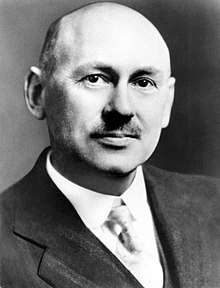Robert Goddard (1882–1945)
Robert Hutchings Goddard (ur. 1882, zm. 1945) – amerykański konstruktor i wynalazca lotniczy, pionier techniki rakietowej i astronautyki. W latach 1919-43 był profesorem uniwersytetu Clarka w Worcester. Uzyskał 214 patentów za opracowania z dziedziny techniki rakietowej. Zbudował pierwszą w historii rakietę na paliwo ciekłe. W 1926 roku odbył się udany start tej rakiety. Szczytowym osiągnięciem Goddarda była budowa rakiety, która w 1941 r. na poligonie w stanie Nowy Meksyk osiągnęła wysokość 3000 m. Goddard doszedł do rozwiązań analogicznych do wprowadzonych później przez Niemców w rakiecie V-2; stosował on sterowanie żyroskopowe, baterie silników, turbinowe pompy paliwa, kardanowe zawieszenie części tylnej pozwalające na sterowanie, „pokładowe“ instrumenty pomiarowe i badawcze.[1] W 1919 roku opublikował pracę pt. Metody zdobywania wielkich wysokości. [2]
Przypisy
- ↑ Janusz Thor, Dzieje techniki rakietowej, „Kwartalnik Historii Nauki i Techniki”, 10/1-2, 1965, s. 217.
- ↑ Stanisław Torecki, 1000 słów o broni i balistyce, Warszawa 1982, s. 84.
| Robert Goddard i jego prace Fragment odcinka serialu dokumentalnego przedstawiającego amerykańską "drogę do gwiazd" | |
| Pomoc | |
Media użyte na tej stronie
Archive footage of Robert Goddard, rocket pioneer of the 1920's and '30's. Ahead of his time, and the first to use liquid propellant. From the 'Moonwalk Series: Episode 1 - "The Day Before"'. A four part documentary series made in the 1970's about the Apollo 11 mission.
Dr. Robert Hutchings Goddard (1882-1945)
Dr. Goddard has been recognized as the father of American rocketry and as one of the pioneers in the theoretical exploration of space. Robert Hutchings Goddard, born in Worcester, Massachusetts, on October 5, 1882, was theoretical scientist, as well as a practical engineer. His dream was the conquest of the upper atmosphere and ultimately space through the use of rocket propulsion. Dr. Goddard, died in 1945, but was likely as responsible for the dawning of the Space Age as the Wright brothers were for the beginning of the Air Age. Yet his work attracted little serious attention during his lifetime. However, when the United States began to prepare for the conquest of space in the 1950's, American rocket scientists began to recognize the debt owed to the New England professor. They discovered that it was virtually impossible to construct a rocket or launch a satellite without acknowledging the work of Dr. Goddard. More than 200 patents, many of which were issued after his death, covered this great legacy.


